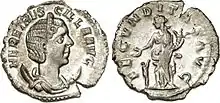Fecunditas
Fecunditas (oder Fecunditas Augusta) ist die römische Personifikation der Fruchtbarkeit, insbesondere der Kaiserinnen.

Antoninian der Herennia Etruscilla mit der Personifikation der Fecunditas auf der Rückseite
Der Fecunditas wurde 63 n. Chr. auf Beschluss des Senats ein Tempel in Rom gelobt, nachdem Poppaea Sabina Kaiser Nero eine Tochter geboren hatte.[1]
Auf Münzen wird Fecundidas von Antoninus Pius bis Claudius Gothicus dargestellt, in der Regel mit einem Zepter in der Hand und einem Kleinkind.
Literatur
- R. Peter: Fecunditas. In: Wilhelm Heinrich Roscher (Hrsg.): Ausführliches Lexikon der griechischen und römischen Mythologie. Band 1,2, Leipzig 1890, Sp. 1471 f. (Digitalisat).
- Georg Wissowa: Fecunditas. In: Paulys Realencyclopädie der classischen Altertumswissenschaft (RE). Band VI,2, Stuttgart 1909, Sp. 2098.
- A. Comotti: Fecundidas. In: Enciclopedia dell’Arte Antica, Classica e Orientale Bd. 3, Rom 1966, S. 611–612 (Volltext).
- Thomas Ganschow: Fecunditas. In: Lexicon Iconographicum Mythologiae Classicae (LIMC). Band VIII, Zürich/München 1997, S. 583–585.
- Brigitte Schaffner: Fecunditas. In: Der Neue Pauly (DNP). Band 4, Metzler, Stuttgart 1998, ISBN 3-476-01474-6, Sp. 455.
Weblinks
Commons: Fecunditas – Sammlung von Bildern, Videos und Audiodateien
This article is issued from Wikipedia. The text is licensed under Creative Commons - Attribution - Sharealike. The authors of the article are listed here. Additional terms may apply for the media files, click on images to show image meta data.